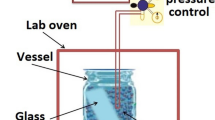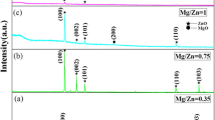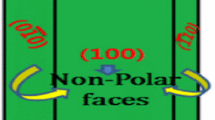Abstract
In the present work, ZnO nanorods have been grown, by hydrothermal method, on glass substrate coated with sputtered ZnO thin film seed layer. The effect of the zinc precursor salt concentration is varied to investigate its effect on the grown nanorod properties. X rays diffraction (XRD), scanning electron microscopy (SEM) technique have been used to analyze the nanorods crystalline structure and morphology. UV–visible optical transmittance and photoluminescence (PL) were used to characterize the nanorods’ optical properties and electronic defects. The XRD analysis reveals the high texturation along the (002) direction indicating the well alignment of the grown nanorods confirmed by the SEM observation. Increasing the salt solution leads to ZnO nanorods with larger diameter and dense ZnO nanorods array. The nanorods optical transmission is characterized by a non-common linear decreasing with wavelength reduction. An explanation model of this behavior is addressed. The PL result analysis suggests that the synthetized ZnO nanorods are formed with Zn-termination polar face.







Similar content being viewed by others
References
L. Mino, G. Agostini, E. Borfecchia, D. Gianolio, A. Piovano, E. Gallo, C. Lamberti, Low-dimensional systems investigated by x-ray absorption spectroscopy: a selection of 2D, 1D and 0D cases. J. Phys. D. Appl. Phys. 46, 423001 (2013). https://doi.org/10.1088/0022-3727/46/42/423001
Z. Lockman, Y. Pet Fong, T. Wai Kian, K. Ibrahim, K.A. Razak, Formation of self-aligned ZnO nanorods in aqueous solution. J. Alloys Compd. 493(1), 699–706 (2010). https://doi.org/10.1016/j.jallcom.2009.12.196
J.H. Yang, J.H. Zheng, H.J. Zhai, L.L. Yang, Y.J. Zhang, J.H. Lang, M. Gao, Growth mechanism and optical properties of ZnO nanotube by the hydrothermal method on Si substrates. J. Alloys Compd. 475, 741–744 (2009). https://doi.org/10.1016/J.JALLCOM.2008.07.123
M.C. Newton, P.A. Warburton, ZnO tetrapod nanocrystals. Mater. Today. 10, 50–54 (2007). https://doi.org/10.1016/S1369-7021(07)70079-2
R.J. Chung, Z.C. Lin, P.K. Yang, K.Y. Lai, S.F. Jen, P.W. Chiu, Hybrid ZnO NR/graphene structures as advanced optoelectronic devices with high transmittance. Nanoscale Res. Lett. 8, 1–5 (2013). https://doi.org/10.1186/1556-276X-8-350/TABLES/1
L. Sang, M. Liao, M. Sumiya, A comprehensive review of semiconductor ultraviolet photodetectors: from thin film to one-dimensional nanostructures. Sensors. 13(8), 10482–10518 (2013). https://doi.org/10.3390/S130810482
Z. Yin, Y. Shan, M. Yu, L. Yang, J. Song, P. Hu, F. Teng, Enhanced performance of UV photodetector based on ZnO nanorod arrays via TiO2 as electrons trap layer. Mater. Sci. Semicond. Process. 148, 106813 (2022)
Q. Zhang, C.S. Dandeneau, X. Zhou, C. Cao, ZnO nanostructures for dye-sensitized solar cells. Adv. Mater. 21, 4087–4108 (2009). https://doi.org/10.1002/ADMA.200803827
R. Kumar, O. Al-Dossary, G. Kumar, A. Umar, Zinc oxide nanostructures for no2 gas–sensor applications: A review. Nano Micro Lett. 7, 97–120 (2015). https://doi.org/10.1007/S40820-014-0023-3/FIGURES/1
A.Y. Al-Sheirey, A. Balouch, E.R. Mawarnis, L. Roza, M.Y. Abd, A.M. Rahman, Mahar., Effect of ZnO seed layer annealing temperature on the growth of ZnO nanorods and its catalytic application. Opt. Mater. 131, 112652 (2022)
X. Fang, Y. Bando, U.K. Gautam, C. Ye, D. Golberg, Inorganic semiconductor nanostructures and their field-emission applications. J. Mater. Chem. 18, 509–522 (2008). https://doi.org/10.1039/B712874F
A.B. Djurišić, X. Chen, Y.H. Leung, A. Man Ching Ng., ZnO nanostructures: growth, properties and applications. J. Mater. Chem. 22, 6526–6535 (2012). https://doi.org/10.1039/C2JM15548F
B. Kumar, S.W. Kim, Energy harvesting based on semiconducting piezoelectric ZnO nanostructures. Nano Energy 1, 342–355 (2012). https://doi.org/10.1016/J.NANOEN.2012.02.001
S. Yingying, A. Nisar, H. Sun, M. Ahmad, W. Shen, M. Wei, J. Zhu, Synthesis of hierarchical flower-like ZnO nanostructures and their functionalization by Au nanoparticles for improved photocatalytic and high performance Li-ion battery anodes Synthesis of hierarchical flower-like ZnO nanostructures and their functionalization by Au nanoparticles for improved photocatalytic and high performance Li-ion battery anodes. J. Mater. Chem. (2011). https://doi.org/10.1039/C1JM10720H
M. Selvakumar, D. Krishna Bhat, A. Manish Aggarwal, S. Prahladh Iyer, G. Sravani, Nano ZnO-activated carbon composite electrodes for supercapacitors. Phys. B Condens. Matter. 405, 2286–2289 (2010). https://doi.org/10.1016/J.PHYSB.2010.02.028
J.S. Chang, M.N. Chong, J.D. Ocon, Determining the structure-antibacterial properties relationship and bacterial inactivation kinetics in different morphological-controlled ZnO nanoarchitectures for wastewater applications. J. Environ. Chemi. Enginee. 9(6), 106646 (2021)
J. Samuel, S. Suresh, S. Shabna, V.S. Vinita, N.J. Ananth, P.M.S. Shinu, A. MariappanTuribiussimon, Y. Samson, C.S. Biju, Characterization and antibacterial activity of Ti doped ZnO nanorods prepared by hydrazine assisted wet chemical route. Physica. E Low Dimens. Syst. Nanostructure 143, 115374 (2022)
F.U. Ahmed, D. Upadhaya, D.D. Purkayastha, M.G. Krishna, Stable hydrophilic and underwater superoleophobic ZnO nanorod decorated nanofibrous membrane and its application in wastewater treatment. J. Membr Sci. 659, 120803 (2022)
M. Shaban, M. Zayed, H. Hamdy, Nanostructured ZnO thin films for self-cleaning applications. RSC Adv. 7, 617–631 (2017). https://doi.org/10.1039/C6RA24788A
A. George, P. Kumari, N. Soin, S.S. Roy, J.A. McLaughlin, Microstructure and field emission characteristics of ZnO nanoneedles grown by physical vapor deposition. Mater. Chem. Phys. 123, 634–638 (2010). https://doi.org/10.1016/J.MATCHEMPHYS.2010.05.029
L. Wang, X. Zhang, S. Zhao, G. Zhou, Y. Zhou, J. Qi, Synthesis of well-aligned ZnO nanowires by simple physical vapor deposition on c-oriented ZnO thin films without catalysts or additives. Appl. Phys. Lett. 86, 024108 (2005). https://doi.org/10.1063/1.1851607
G. Jimenez-Cadena, E. Comini, M. Ferroni, A. Vomiero, G. Sberveglieri, Synthesis of different ZnO nanostructures by modified PVD process and potential use for dye-sensitized solar cells. Mater. Chem. Phys. 124, 694–698 (2010). https://doi.org/10.1016/J.MATCHEMPHYS.2010.07.035
R. Wahab, S.G. Ansari, Y.S. Kim, H.K. Seo, G.S. Kim, G. Khang, H.S. Shin, Low temperature solution synthesis and characterization of ZnO nano-flowers. Mater. Res. Bull. 42, 1640–1648 (2007). https://doi.org/10.1016/J.MATERRESBULL.2006.11.035
R. Al-Gaashani, S. Radiman, A.R. Daud, N. Tabet, Y. Al-Douri, XPS and optical studies of different morphologies of ZnO nanostructures prepared by microwave methods. Ceram. Int. 39, 2283–2292 (2013). https://doi.org/10.1016/J.CERAMINT.2012.08.075
J. Kissi, B. Dai Courage, S.K. Dogbe, J. Banahene, O. Ernest, B. Dai, Predictive factors of physicians’ satisfaction with telemedicine services acceptance. Health Inform. J. 26(3), 1866–1880 (2020). https://doi.org/10.1177/1460458219892162
P.N. Mbuyisa, O.M. Ndwandwe, C. Cepek, Controlled growth of zinc oxide nanorods synthesised by the hydrothermal method. Thin Solid Films 578, 7–10 (2015). https://doi.org/10.1016/J.TSF.2015.02.002
N.R. Khalid, H. Ishtiaq, F. Ali, M.B. Tahir, S. Naeem, A. Ul-Hamid, M. Ikram, T. Iqbal, M.R. Kamal, H. Alrobei, M. Alzaid, A. Dahshan, Synergistic effects of Bi and N doped on ZnO nanorods for efficient photocatalysis. Mater. Chem. Phys. 289, 126423 (2022)
Huey Jing Tan, ZulkarnainZainal, Zainal AbidinTalib, Hong, NgeeLim, Suhaidi Shafie, Sin TeeTan, Kar BanTan, Noor NazihahBahrudin, Synthesis of high quality hydrothermally grown ZnO nanorods for photoelectrochemical cell electrode. Ceram. Int. 47, 14194 (2021)
H. Krajian, B. Abdallah, M. Kakhia, N. AlKafri, Hydrothermal growth method for the deposition of ZnO films: Structural, chemical and optical studies. Microelectron. Reliab. 125, 114352 (2021)
M.P.F. de Godoy, L.K.S. de Herval, A.A.C. Cotta, Y.J. Onofre, W.A.A. Macedo, ZnO thin films design: the role of precursor molarity, in the spray pyrolysis process. J Mater Sci: Mater Electron 31(20), 17269–17280 (2020)
D. Poelman, P.F. Smet, Methods for the determination of the optical constants of thin films from single transmission measurements: a critical reviewJ. Phys. D: Appl. Phys. 36, 1850 (2003)
G.B. Harris, X Quantitative measurement of preferred orientation in rolled uranium bars. Dublin Philos. Mag. J. Sci. 43(336), 113–123 (2009). https://doi.org/10.1080/14786440108520972
S.M.A. Rastialhosseini, A. Khayatian, R. Shariatzadeh, M. Almasi Kashi, Three-dimensional ZnO nanorods growth on ZnO nanorods seed layer for high responsivity UV photodetector. Appl. Phys. A 125(12), 1–13 (2019). https://doi.org/10.1007/S00339-019-3123-6
A. Lestari, S. Iwan, D. Djuhana, C. Imawan, A. Harmoko, V. Fauzia, Effect of precursor concentration on the structural and optical properties of ZnO nanorods prepared by hydrothermal method. AIP Conf. Proc. 1729, 020027 (2016). https://doi.org/10.1063/1.4946930
J.J. Tauc, Amorphous and Liquid Semiconductors (Plenum Press, London & New York, 1974)
W. Song, X. Yu, D.C. Markel, M.R. Hashim, W. Maryam, Influence of concentration on the geometry of ZnO nanostructures prepared by chemical bath deposition. J. Phys. Conf. Ser. 137(1), 012015 (2019). https://doi.org/10.1088/1742-6596/1371/1/012015
R. Idiawati, N. Mufti, A. Taufiq, Effect of growth time on the characteristics of ZnO nanorod Iopscience. Mater. Sci. Eng (2017). https://doi.org/10.1088/1757-899X/202/1/012050
N. Idiawati, A. Mufti, Effect of growth time on the characteristics of ZnO nanorods. Iopsci. Iop. Org. 202, 012050 (2017)
M.H. Majeed, M. Aycibin, A. GencerImer, A.M. Muhammad, M.M. Kareem, Influence of annealing process on structural, optical and electronic properties of nano-structured ZnO films synthesized by hydrothermal technique: Supported by DFT study. Mater. Sci. Eng. B 282, 115793 (2022)
M. Shirazi, R. Sabet Dariani, M.R. Toroghinejad, Influence of doping behavior of Al on nanostructure, morphology and optoelectronic properties of Al Doped ZnO thin film grown on FTO substrate. J. Mater. Sci. Mater. Electron. 27(10), 10226–10236 (2016). https://doi.org/10.1007/S10854-016-5101-5
H. Gupta, J. Singh, R.N. Dutt, S. Ojha, S. Kar, R. Kumar, V.R. Reddy, F. Singh, Defect-induced photoluminescence from gallium-doped zinc oxide thin films: influence of doping and energetic ion irradiation. Phys. Chem. Chem. Phys. 21, 15019–15029 (2019). https://doi.org/10.1039/C9CP02148E
S.S. Shinde, P.S. Shinde, R.T. Sapkal, Y.W. Oh, D. Haranath, C.H. Bhosale, K.Y. Rajpure, Photoelectrocatalytic degradation of oxalic acid by spray deposited nanocrystalline zinc oxide thin films. J. Alloys Compd. 538, 237–243 (2012). https://doi.org/10.1016/J.JALLCOM.2012.05.124
R. Udayabhaskar, B. Karthikeyan, Role of micro-strain and defects on band-gap, fluorescence in near white light emitting Sr doped ZnO nanorods. J. of Appl. Phys. 116, 094310 (2014). https://doi.org/10.1063/1.4893562
S. Dutta, S. Chattopadhyay, A. Sarkar, M. Chakrabarti, D. Sanyal, D. Jana, Role of defects in tailoring structural, electrical and optical properties of ZnO. Prog. Mater. Sci. 54(1), 89–136 (2009)
C.W.-P. in surface science, undefined 2007, The chemistry and physics of zinc oxide surfaces, Elsevier. (n.d.). https://www.sciencedirect.com/science/article/pii/S0079681606000955 (accessed July 4, 2022).
F.O.-T.J. Torbrügge, of P., Stabilization of zinc-terminated ZnO (0001) by a modified surface stoichiometry. ACS Publ. 113(12), 4909–4914 (2009). https://doi.org/10.1021/jp804026v
J.H. Lee, J.H. Shin, J.Y. Song, W. Wang, R. Schlaf, K.J. Kim, Y. Yi, Interface formation between ZnO nanorod arrays and polymers (PCBM and P3HT) for organic solar cells. J. Phys. Chem. C. 116, 26342–26348 (2012). https://doi.org/10.1021/JP3081468
M.W. Allen, C.H. Swartz, T.H. Myers, T.D. Veal, C.F. McConville, S.M. Durbin, Bulk transport measurements in ZnO: The effect of surface electron layers. Phys. Rev. B Condens. 81, 075211 (2010). https://doi.org/10.1103/PHYSREVB.81.075211/FIGURES/5/MEDIUM
C.H. Swartz, Transport and surface conductivity in ZnO. J. Mater. Res. 27, 2205–2213 (2012). https://doi.org/10.1557/JMR.2012.133
R. Heinhold, G.T. Williams, S.P. Cooil, D.A. Evans, M.W. Allen, Influence of polarity and hydroxyl termination on the band bending at ZnO surfaces. Phys. Rev. B Condens. Matter Mater. Phys. (2013). https://doi.org/10.1103/PHYSREVB.88.235315
M. Losurdo, M.M. Giangregorio, Interaction of atomic hydrogen with Zn-polar and O-polar ZnO surfaces. Appl. Phys. Lett. 86, 091901 (2005). https://doi.org/10.1063/1.1870103
Author information
Authors and Affiliations
Corresponding author
Additional information
Publisher's Note
Springer Nature remains neutral with regard to jurisdictional claims in published maps and institutional affiliations.
Rights and permissions
Springer Nature or its licensor holds exclusive rights to this article under a publishing agreement with the author(s) or other rightsholder(s); author self-archiving of the accepted manuscript version of this article is solely governed by the terms of such publishing agreement and applicable law.
About this article
Cite this article
Al-Rasheedi, A., Alonizan, N.H., Ansari, A.R. et al. Influence of salt solution concentration on structural properties of ZnO nanorods grown by hydrothermal method. Appl. Phys. A 128, 782 (2022). https://doi.org/10.1007/s00339-022-05937-8
Received:
Accepted:
Published:
DOI: https://doi.org/10.1007/s00339-022-05937-8




